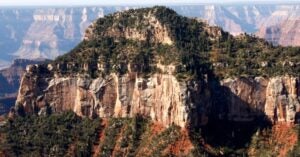Amid the controversy surrounding foreign land ownership, Presiden Joe Biden signed a proclamation designating just under 1 million acres in Arizona as a new national monument near the Grand Canyon yesterday.
While the proclamation appears on the surface to be a move to conserve Native American cultural sites while protecting the area from uranium mining (essential to “clean energy” initiatives), it’s facing severe opposition from private landowners, ranchers, state agricultural organizations, and mining supporters.
The new monument will span 917,618 acres of federal forest and range lands, an area slightly smaller than the originally proposed 1.1 million acres, making it the 19th national monument in Arizona. Its area lies along the Arizona Strip, a unique region north of the Grand Canyon and south of the Utah border, nearly connecting the existing Grand Canyon-Parashant National Monument, Grand Canyon National Park, and Vermillion Cliffs National Monument with the Grand Staircase Escalante National Monument.

The problem? While the designation says it will protect existing grazing leases, hunting, fishing, and recreational access, Arizona’s ranchers and other groups are voicing their concerns that the federal land takeover will permanently lock up nearly 1 million additional acres in a state where 80 percent of the land is already under federal control.
A petition on change.org stated, “If the other nearby national monuments are any indicator, this attempt to permanently lock up over 1.1 million acres will permanently prevent uranium mining and likely restrict grazing to levels that make ranching extremely cost prohibitive and difficult.”
Utah, pay heed. Opponents say that it’s not just Arizona’s ranchers and miners eho will be affected. The monument will likely impact producers in Southern Utah who utilize grazing along the Arizona strip.
Leaders in the northwestern part of the state are also concerned. Mohave County, known for its ranchlands, is included in the new monument’s northwestern segment, opposed the creation, which provides for over 400,000 acres of takeover within the county.
While Mohave County was excluded from discussions, reports indicate that a meeting was held for public comment in Coconino County, where the effort is widely supported.
During a meeting in Kingman, Arizona, multiple ranchers spoke out against the monument, including Mike Gannuscio, Arizona Cattle Growers’ president, and an Arizona Farm Bureau representative.
AZcentral reported that Chris Heaton, a rancher from Utah who ranches 40 miles north of the Grand Canyon, presented a map during the meeting that showed the proposed monument taking over land his family has owned and worked since before Arizona became a state.
Heaton said he was never contacted about the monument.
In an update today, Heaton shared with Fox Business that the newest updated map of three versions has finally excluded about 1,000 acres of private land. However, 40,000 of his federal and state land won’t be safe, and Heaton is concerned that the monument will impact his grazing rights and private water rights, which are integral not only to cattle but native wildlife in the area as well.
The Biden administration announced that an additional $44 million is slated to strengthen climate resilience across national park systems in addition to its newest designation.
»Related: Farm Bureau concerned about Biden’s 30×30 executive order


